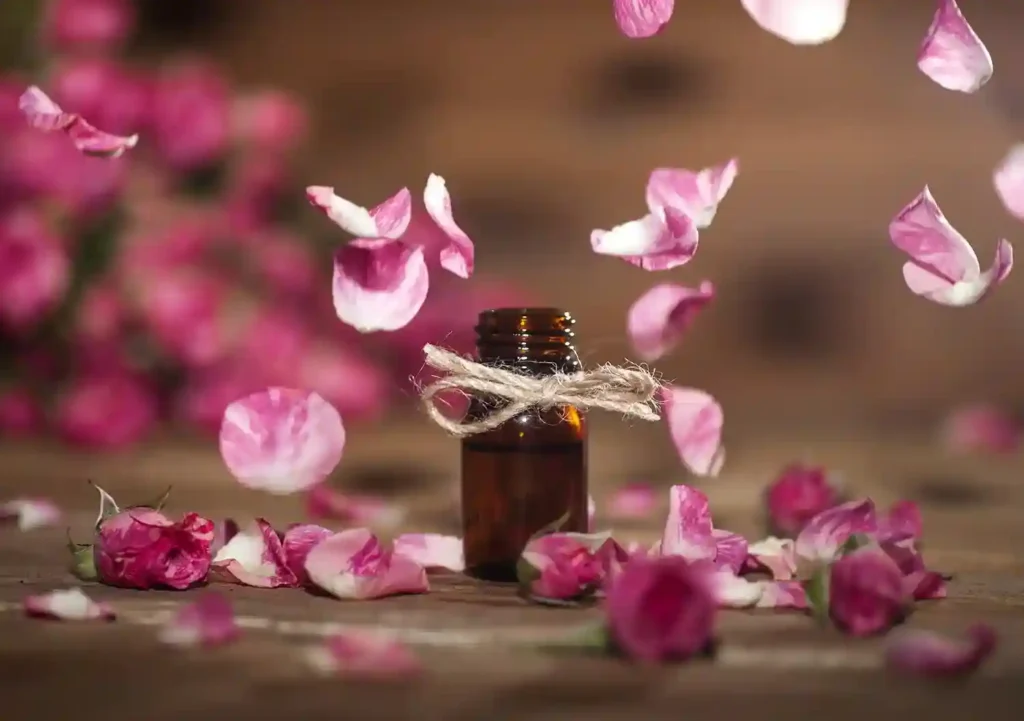Welcome to the enchanting world of Rose oil, a natural elixir that has captivated hearts and senses for centuries. This comprehensive post invites you to explore the multifaceted wonders of Rose oil, a treasure trove of benefits for both the skin and the soul.
From its rich historical roots to its modern-day applications, Rose oil is a testament to nature’s prowess and a symbol of luxury and wellness.
As we delve into the depths of its properties, uses, and the science behind its potency, prepare to uncover the secrets of this cherished essence and how it can transform your approach to natural beauty and holistic well-being.
Introduction to Rose Oil
Rose oil, esteemed for its exquisite fragrance and therapeutic properties, has been a cherished commodity throughout history.
The Historical Significance of Rose Oil
Rose oil’s history is as rich and colourful as its scent. For thousands of years, it has been a symbol of love, beauty, and luxury across various cultures.
The ancient Persians are believed to have first distilled rose oil and used it in cosmetics and medicines. In Egypt, Cleopatra famously added it to her baths to enhance her allure. The Romans used rose oil in their lavish feasts and public baths. It was highly prized in Europe during the Middle Ages for its fragrance and medicinal properties.
This historical legacy underlines the enduring appeal of rose oil and its status as a luxury item.
Understanding the Extraction Process
The extraction of rose oil is a delicate process, contributing to its high value. The most common method is steam distillation, where rose petals (of the Rosa centifolia L. and Rosa damascena Mill.) are placed in a still, passing steam through them.
The steam extracts the oil from the petals, and the mixture of steam and oil is then cooled to separate the oil. This method preserves the oil’s natural fragrance and properties.
Approximately 10,000 pounds of rose petals are required to produce just one pound of oil, making it one of the most expensive essential oils. The Rosa damascena, primarily grown in Bulgaria, Turkey, and Iran, is the most commonly used rose variety for oil production.
Understanding rose oil’s historical and cultural significance and its extraction process provides a foundation for appreciating its value and the reasons behind its widespread use in aromatherapy, skincare, and perfumery.
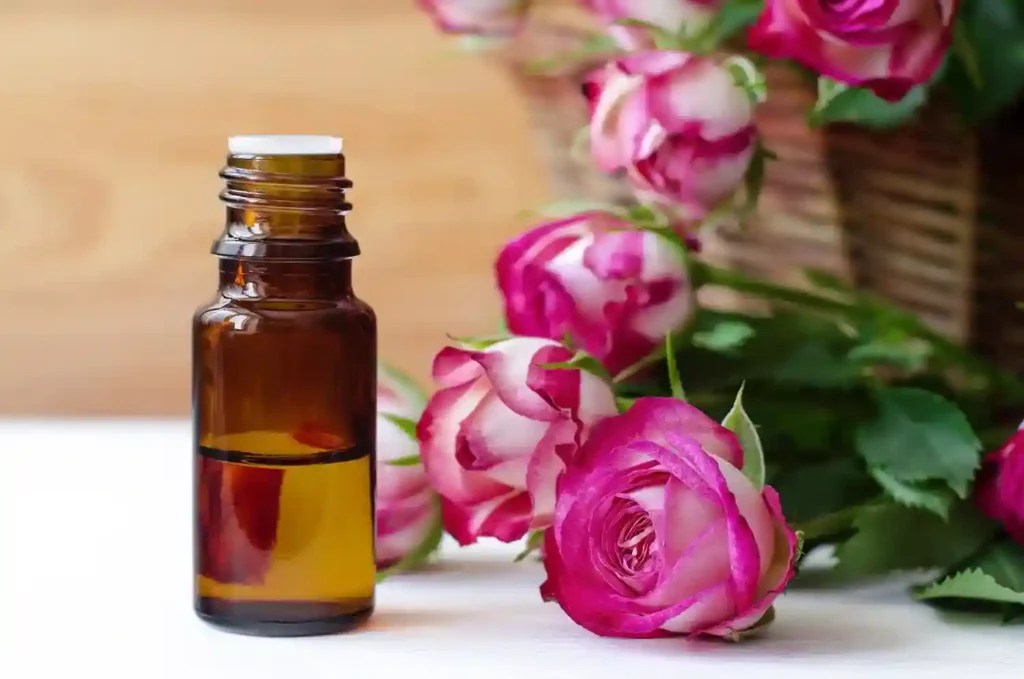
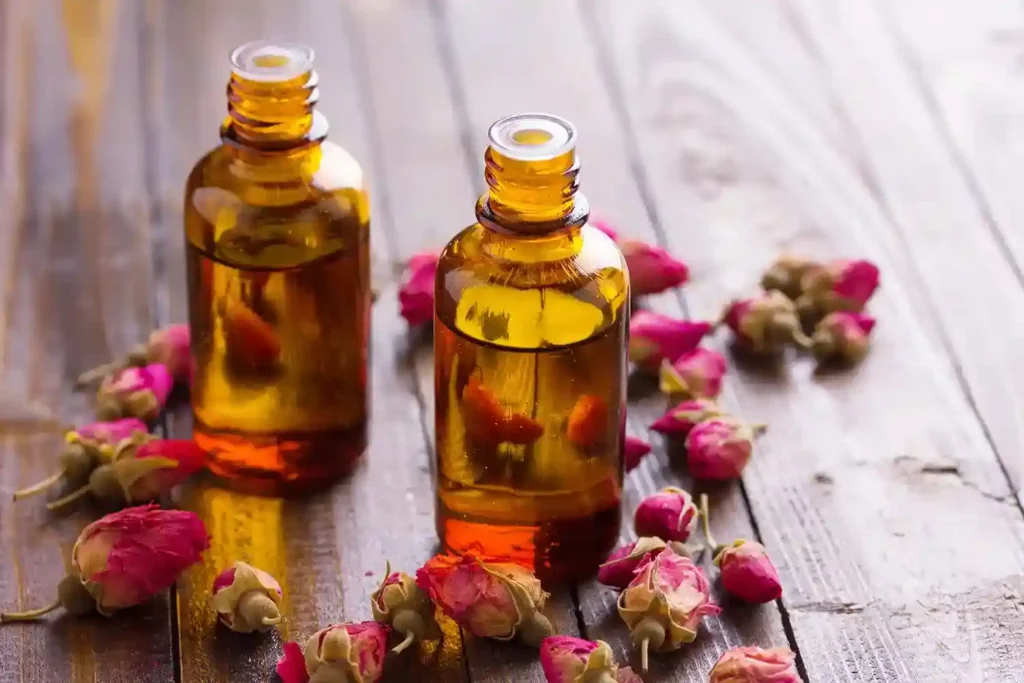
Rose Oil Benefits for Skin & Wellbeing
Skin Care Wonders
Rose oil is a powerhouse in skin care, offering many benefits for various skin types and conditions. Its rich composition makes rose oil a highly sought-after ingredient in beauty and skincare products.
Anti-Ageing Properties
Rose oil is celebrated for its remarkable anti-ageing properties. It’s packed with antioxidants that help combat free radicals, reducing the appearance of wrinkles and fine lines. Its emollient nature also aids in hydrating the skin, giving it a plump, youthful glow.
Combating Acne and Skin Irritations
Rose oil’s antiseptic and antibacterial properties make it an effective remedy for acne and other skin irritations. It helps support the skin in balancing itself and healing naturally, which are key factors in acne management. Additionally, its soothing properties help reduce redness and inflammation.
Hydration and Tone Improvement
Rose oil is a natural hydrator, suitable for even sensitive types. It helps lock in moisture, leaving the skin feeling soft and supple. Regular use may lead to an improved skin tone, diminishing spots and blemishes for a more even complexion.
Hair Care Uses
Rose oil, renowned for its nourishing properties, is a valuable addition to hair care. When massaged into the scalp, it moisturises, soothes irritation, and balances oil production. Its luxurious fragrance also imparts a soothing effect, making it ideal for a relaxing hair care routine that promotes overall scalp health.
Many factors, such as genetics, general health, and hair care routines, influence hair growth. While there is no direct correlation between rose oil and the stimulation of hair growth, it plays a supportive role in maintaining a healthy scalp and hair follicles. This, in turn, creates favourable conditions for hair growth.
Health and Emotional Well-being
Beyond its many skin benefits, rose oil promotes overall health and emotional well-being.
Alleviating Stress and Anxiety
The aroma of rose oil is known for its calming effects on the mind, making it a popular choice in aromatherapy. It helps in reducing stress and anxiety levels, promoting a sense of relaxation and peace.
Pain Relief and Menstrual Comfort
Rose oil has traditionally alleviated pain, including headaches and menstrual cramps. Its anti-inflammatory properties may help in reducing discomfort and easing pain.
Antidepressant Effects
The uplifting fragrance of rose oil can positively impact mood, making it a natural antidepressant. It’s known to boost self-esteem, confidence, and mental strength while efficiently fighting depression.
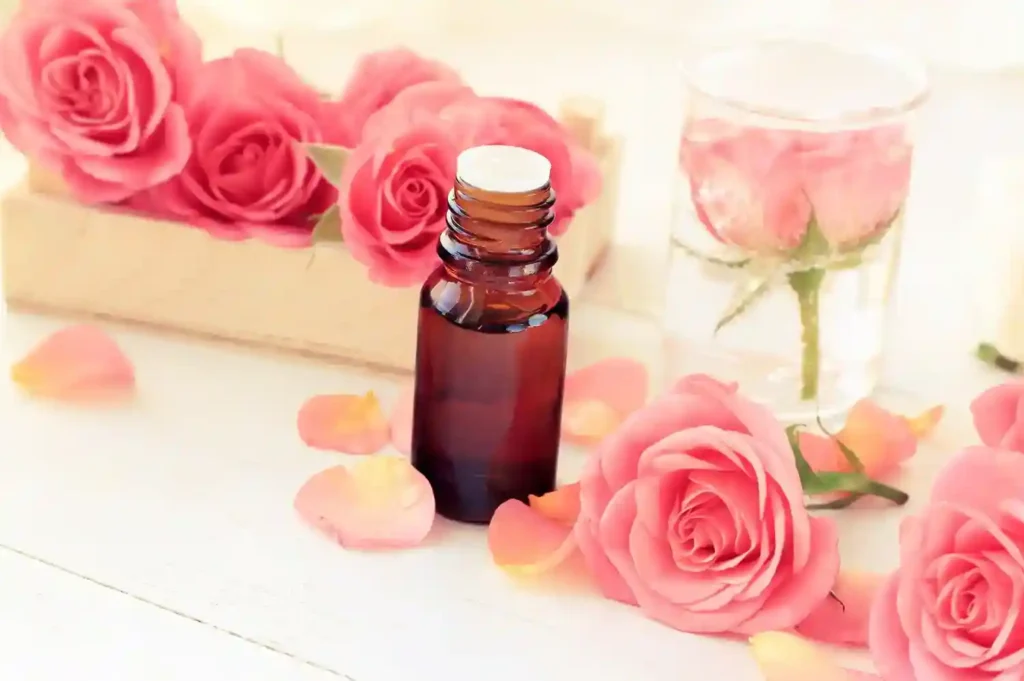
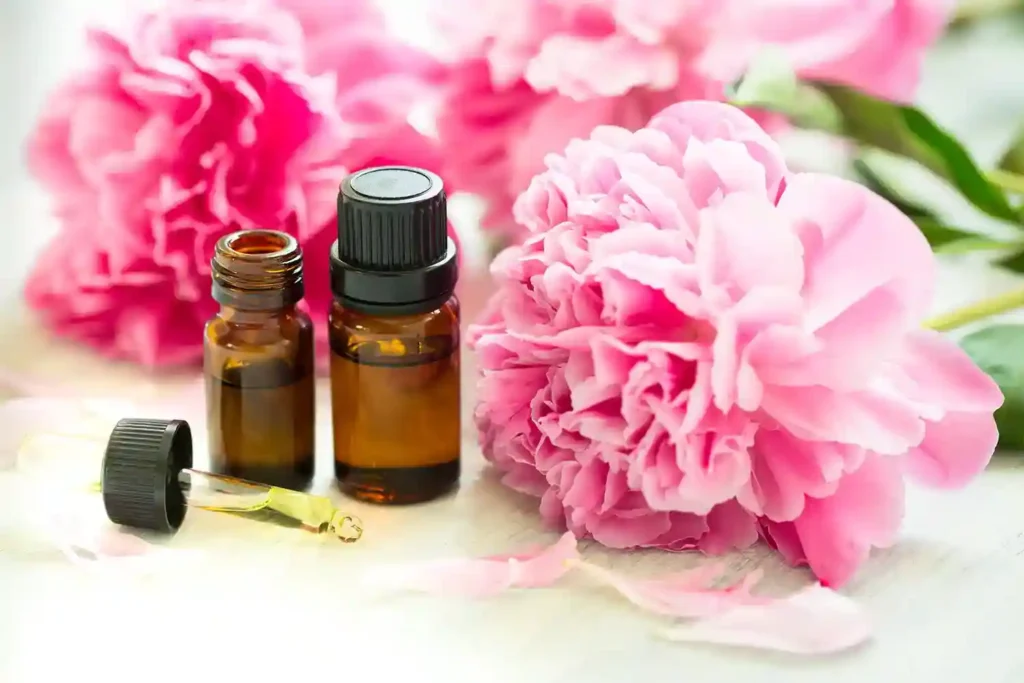
The Science Behind Rose Oil
Delving into the science behind rose oil reveals why it’s so revered in skincare and aromatherapy. Let’s explore the key components and their effects on the skin and mind.
Analysing the Antioxidant and Anti-inflammatory Properties
Rose oil is rich in compounds like citronellol and geraniol, contributing to its antioxidant and anti-inflammatory properties. These compounds may help protect the skin from oxidative stress caused by environmental pollutants and UV rays.
Antioxidants neutralise free radicals, preventing them from damaging skin cells, which can lead to premature ageing. The anti-inflammatory properties of rose oil make it effective in soothing irritated skin, reducing redness, and calming conditions like eczema and rosacea.
Rose Oil in Aromatherapy: More Than Just a Pleasant Scent
The benefits of rose oil in aromatherapy are rooted in its interaction with the limbic system, the brain’s emotional centre. When inhaled, the molecules of rose oil stimulate this part of the brain, influencing mood, stress levels, and even hormonal balance.
This is why rose oil is often used to alleviate symptoms of anxiety and depression, promote relaxation, and improve overall well-being. Studies have shown that the aroma of rose oil can decrease cortisol levels (the stress hormone) and increase feelings of calmness and relaxation.
How To Use Rose Oil
Essential oils, including pure rose oil, are highly concentrated and should be used carefully; proper dilution and application are crucial for their safe and effective use.
Here are some methods and tips:
Dilution Techniques
Using Carrier Oils: Select a carrier oil like Jojoba oil, Coconut oil, Sweet Almond oil, or Evening Primrose oil. These oils are gentle on the skin whilst offering their own intrinsic benefits, particularly when combined with Rose oil.
Mixing Ratios: A general guideline is to add 1 to 2 drops of rose oil to 10ml of carrier oil. This ratio ensures the rose oil is effectively diluted but retains its benefits.
Application Methods
Direct Application: After dilution, apply the oil mixture directly to the skin. Use your fingertips to gently massage the oil in a circular motion to promote absorption and circulation, focusing on areas prone to dryness or wrinkles.
Facial Use: Ensure the mixture is light for facial application to avoid clogging pores. Apply after cleansing and toning and before applying your regular moisturiser.
Adding to Products: You can also add a few drops of diluted rose oil to your existing skincare products like lotions or creams for an added boost.
Rose Oil Bath: To prepare a rose oil bath, mix five drops of rose essential oil into 20g of plain bath salt and sprinkle under the running water.
General Tips for Use
Consistency: Incorporate rose oil into your daily skincare routine for best results.
Sensitive Areas: Avoid applying rose essential oil too close to the eyes or on broken skin.
Night Use: Consider using rose oil in your nighttime routine, as its soothing properties are beneficial during the skin’s natural repair process at night.
Storage: Keep your rose oil mixture in a dark, cool place to maintain its efficacy.
Trusted Suppliers: When purchasing your Rose oil, buy only from trusted sources. Rose oil distillation has a low yield, making high-quality rose oil very expensive. Due to this, it is often adulterated with aromatic chemicals to boost fragrance. Rose Otto is often considered the superior choice of rose essential oils and is produced from Rosa Damascena, also known as the Damask Rose. Contact us for our recommendations.
By following these methods and tips, you can safely enjoy the rejuvenating benefits of rose oil in your skincare regimen.
Using Rose Oil in Aromatherapy and Massage
The application of rose oil in aromatherapy and massage taps into its therapeutic properties, enhancing mental and physical well-being. Let’s look at how to use rose oil effectively in these practices.
Creating a Relaxing Atmosphere with Rose Oil in Aromatherapy
Diffusion: Add a few drops (1 or 2 is enough) of rose oil to a diffuser to fill the room with its calming aroma. This can help reduce stress and anxiety, promote better sleep, and create a soothing environment.
Personal Inhalers: For a more personal experience, add rose oil to a personal inhaler or a few drops on a handkerchief to breathe in its relaxing scent throughout the day.
Combining with Other Oils: Rose oil blends well with Lavender oil and Sandalwood oil for relaxation, Bergamot oil for an uplifting mood, and Frankincense oil for tranquillity.
Enhancing Massage Therapy with Rose Oil
Massage Oil Blends: Mix rose oil with a carrier oil like Grapeseed or Sweet Almond oils for a luxurious massage oil. The anti-inflammatory properties of rose oil help soothe sore muscles and joints, while its scent relaxes the mind.
Focusing on Pressure Points: Apply the rose oil blend to pressure points such as the temples, wrists, and behind the ears for a calming effect.
Facial Massage: A facial massage with rose oil can be particularly rejuvenating. Its properties help tone and hydrate the skin, leaving it glowing and full of lustre.
Incorporating rose essential oil into aromatherapy and massage enhances the sensory experience and leverages its therapeutic benefits for the mind and body. Whether used for personal relaxation or in a professional setting, rose oil can significantly elevate the massage and aromatherapy experience.
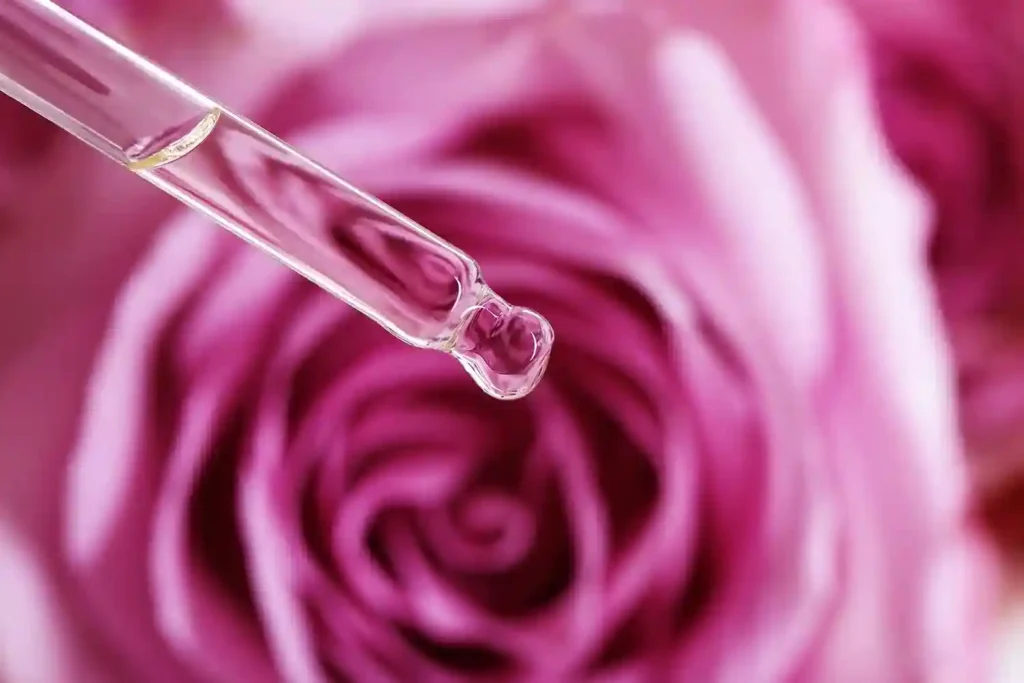
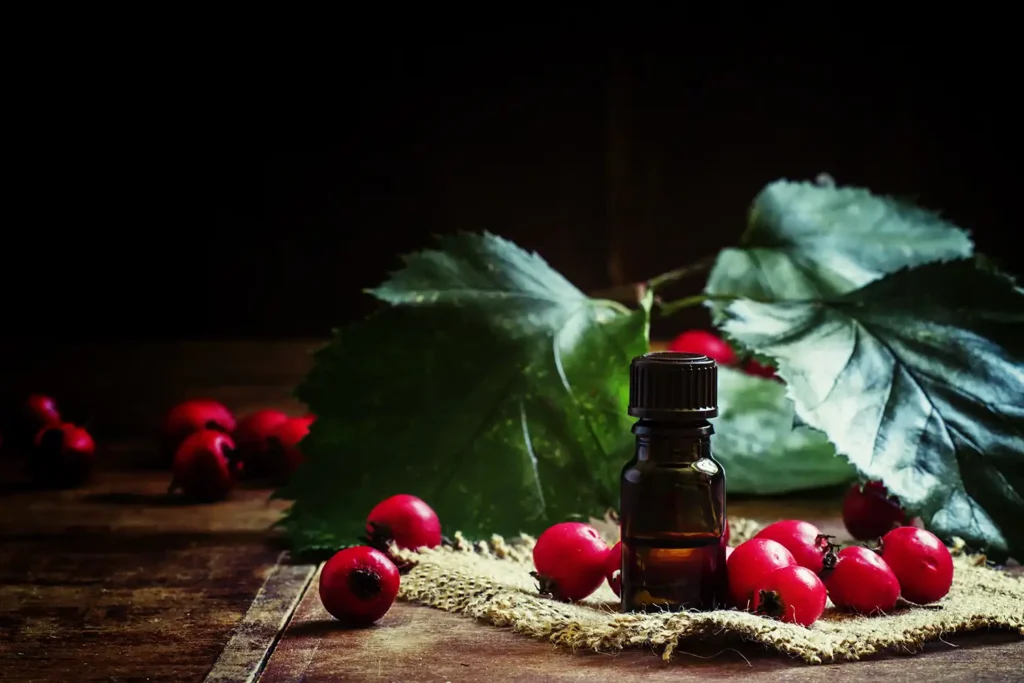
Understanding the Varieties: Rose Essential Oil vs. Rosehip Seed Oil
Navigating the world of botanical oils can be complex, especially when understanding the differences between similarly named products.
Distinctive Features and Uses
Rose essential oil and rosehip oil, derived from the rose plant, are extracted from different parts and have unique characteristics.
Rose Essential Oil
Extracted from the petals of roses (of the Rosa centifolia L. and Rosa damascena Mill.) primarily through steam distillation, this oil is highly concentrated and known for its intense, floral fragrance. It’s rich in therapeutic compounds like citronellol, geraniol, and phenylethyl alcohol. Rose essential oil is primarily used for its skin-soothing properties, making it beneficial for conditions like acne, rosacea, and eczema. It’s also widely used in aromatherapy for its ability to alleviate stress and anxiety.
Rosehip Seed Oil
Pressed from the seeds of the Rosa canina, Rosa moschata, or Rosa rubiginosa rose bush, rosehip oil is a carrier oil, rich in essential fatty acids, vitamins A and C, and antioxidants. It’s known for its hydrating and anti-ageing properties, making it effective in treating dry skin, reducing the appearance of scars and wrinkles, and improving skin elasticity. Unlike rose essential oil, rosehip oil does not have a strong fragrance.

Precautions and Considerations
While rose oil offers numerous benefits, it’s important to use it cautiously to avoid potential side effects.
Potential Side Effects and How to Avoid Them
Rose oil is generally safe for most people, but like all essential oils, it can cause adverse reactions in some cases.
Skin Irritation and Allergic Reactions: The most common side effect of any essential oil use is skin irritation or allergic reactions, particularly in those with sensitive skin. Symptoms may include redness, itching, or rash. Always dilute essential oils with a carrier oil before topical application to minimise this risk.
Patch Testing Before Use: Conduct a patch test before incorporating rose oil into your routine. Apply a small amount of diluted oil to a discreet skin area and monitor for 24-48 hours for any signs of reaction, such as irritation or redness.
Special Considerations
Certain groups need to exercise extra caution when using rose oil.
Individuals with Sensitive Skin: Those with sensitive skin or conditions like eczema and rosacea should perform a patch test before using rose oil.
Pregnancy and Breastfeeding: Pregnant and breastfeeding women should consult a Professional Essential Oil Therapist before using rose oil.
Hormone-Sensitive Conditions: Since rose oil is generally considered to potentially have estrogen-like effects, it is worth consulting a professional if you have any concerns.
By adhering to these precautions and considerations, users can enjoy the benefits of rose oil while minimising the risk of adverse reactions.

Final Thoughts: The Timeless Elegance of Rose Oil
In summary, Rose oil is a remarkable natural product with a rich history and many benefits. Its journey from ancient to modern-day use underscores its enduring appeal and versatility.
The meticulous extraction process, requiring thousands of petals for a small yield, justifies its status as one of the most valued essential oils. In skincare and aromatherapy, rose oil’s properties may offer significant benefits, from enhancing skin health to promoting emotional well-being.
However, it’s important to use it responsibly, considering the precautions for sensitive skin and specific health conditions. Pure rose essential oil remains a timeless and potent essence, deeply rooted in tradition yet continually relevant in contemporary wellness practices.


